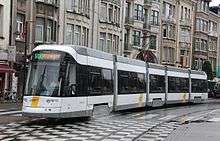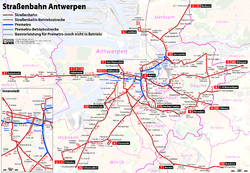Trams in Antwerp
 An Albatros tram in Antwerp, 2016. | |||||||||||||||||||
| Operation | |||||||||||||||||||
|---|---|---|---|---|---|---|---|---|---|---|---|---|---|---|---|---|---|---|---|
| Locale | Antwerp, Belgium | ||||||||||||||||||
| |||||||||||||||||||
| |||||||||||||||||||
The Antwerp tramway network (Dutch: het Antwerpse tramnet) is a network of tramways forming part of the public transport system in Antwerp, a city in the Flemish region of Belgium. The network is operated by the Flemish region's transportation company De Lijn. As of 2015, it featured thirteen lines, seven of which pass partially underground (known as Antwerp Pre-metro).
General description
Antwerp tram system features segment of different characteristics, from following along with street traffic to underground tunnels, which do not differ much from subway rail setup — 1,000 mm (3 ft 3 3⁄8 in) track gauge, 600 volts catenary power feed.
Horse trams, and Omnibus
Horse-drawn trams were the predecessor of nowadays electric trams. The first order for the existence of the «American Tram» (fr. Tramway Américain), as the horse tram was referred that time, was addressed to the citywide proprietors Ed. Paujaurd’hui and A. Edvard still on June 27, 1865, however just 6 years later (March 14, 1871) city council allowed the construction of tram lines. The first horse tram line opened in Antwerp on May 25, 1873. It linked church in Berchem district with Meir avenue in the city center.
Nine years later, there were already 9 lines of horse-drawn tram in Antwerp. There was also one omnibus route there. The public transport of Antwerp was exploited by 9 different companies. One of them operated omnibus, other eight — various horse tram routes.
Electrification
The work permit for electrifying the tram system was granted by CGTA on March 12, 1902 just after half year form applying. (November 22, 1901). Along with electrification it was planned to rebuild lines from 1,435 mm (4 ft 8 1⁄2 in) gauge to 1,000 mm (3 ft 3 3⁄8 in).
The works started on the omnibus route Draakplaats — Grote Markt (now - route № 11). In fact this is the first tram line which stated to work, since omnibuses are road transport, rather than rail transport. Therefore there were no infrastructure built before electrifying this line.
On May 6, 1902 along the way of the former omnibus route, tracks were laid, from Draakplaats to Nieuwstraat. After that the tracks started to be rebuilt along with the electrification of the horse drawn line on the boulevard ring (Leien). For a time of work, omnibuses which became unused temporarily replaced horse drawn cars. On July 9, 1902 horse drawn cars started to move on a former omnibus route segment from Nieuwstraat to Grote Markt.
The first gantry for an electric tram line was installed on June 10, 1902 on the Kunstlei boulevard (now Frankrijklei), between the crossing of streets De Keyserlei Gemeenteplaats (Fr. Rooseveltplaats). On August 13, 1902 the catenary was connected to the temporary electric power substation, which was erected in a tram depot on Boudewijnstraat. Then the electric tram test rides started. The normal operation of an electric tram started on September 2, 1902 . First there was a mix of electric trams and horse cars on the line. And then, the horse-drawn trams left the boulevards of Antwerp - forever.
Tram lines
| line | route | journey time* | average speed* |
|---|---|---|---|
| 2 | Merksem (P+R Keizershoek) – Hoboken (Kioskplaats) | 46 min | ? km/h |
| 3 | Zwijndrecht (Melsele Krijgsbaan) – Merksem (P+R Keizershoek) | 40 min | 22 km/u |
| 4 | Hoboken (Kioskplaats) – Silsburg | 16/29 min** | ? km/h |
| 5 | Wijnegem – Linkeroever (P+R) | 37 min | 26 km/h |
| 6 | Metropolis – Olympiade | 35 min | 17 km/h |
| 7 | Sint Pietersvliet – Mortsel (Gemeenteplein) | 28 min | 17 km/h |
| 8 | Astrid - Wommelgem (P+R) | 15 min | 24 km/h |
| 9 | Linkeroever (P+R) –Deurne, Belgium (Eksterlaar) | 26 min | ? km/h |
| 10 | Melkmarkt – Wijnegem | 30 min | 17 km/h |
| 11 | Melkmarkt – Antwerpen-Berchem railway station | 19 min | ? km/h |
| 12 | Sportpaleis – Zuid – Groenplaats | 25 min | ? km/h |
| 15 | Linkeroever (P+R) – Boechout (P+R Capenberg) | 44 min | ? km/h |
| 24 | Hoboken (Schoonselhof) – Deurne (Silsburg) | 50 min | 15 km/h |
Rolling stock
In August 2012, De Lijn ordered a fleet of Flexity 2 trams from Bombardier, including 28 for Antwerp. These would replace many of the older PCC trams, and displace Hermelijn trams onto other routes.[1]
See also
References
- ↑ "De Lijn orders Flexity 2 trams for Antwerpen and Gent". Railway Gazette International. Retrieved 20 August 2012.
